How Procurement Digitization Enhances Strategic Decision-Making

How Procurement Digitization Enhances Strategic Decision-Making
According to a McKinsey report, nearly 81% [1] of company heads believe the old way of handling essential company purchases needs to be updated. As per a PWC survey, even 86% [2] of the top leaders agree technology is the key to bringing the supply chain to order. In this regard, procurement digitization is the most important step in having a supply chain that is connected, smart, and works well.
4 Benefits of Digital Procurement
Automated Workflows
About 69% [3] of boring tasks that have to do with managing things will be done by computers automatically. Technology has changed how businesses buy stuff. It makes jobs that used to be done by hand happen automatically and lets people see how money is being spent immediately. Using software to buy things is also trending. This software works well with big computer systems like SAP and Oracle to pull out information about orders, bills, and payments. You can eliminate the need to enter data by hand to save time. It also makes things more accurate and costs less to process.
Access to Real-time Analytics
Around 60% [4] of companies worldwide use instant data analysis to help make business choices. They have special dashboards powered by business intelligence tools that show important information about buying things, like how much money is being managed, how much is saved, how well the process works, and how good the suppliers are. Strong analysis of past purchases also helps you make decisions based on data. You can quickly decide where to get things and contracts for the best value. These days, businesses also use machine learning (a smart computer program) to analyze. These machine-learning programs can spot early signs of unusual spending and risks. This way, you can avoid big mistakes easily.
Streamlined Procurement
A report from Deloitte says that nearly 83% [5] of the people in charge of buying things for companies are using digital ways to make buying easier. E-procurement platforms, which are online systems for buying, bring everything together in one place. They make buying simpler and the same across different parts of the business, and they use special steps to ensure everything is done right and follows the rules. Suppliers and sellers connect to these systems for an easy way to handle orders, bills, and payments all on one platform.
Improved Cycle Time
About 83% [6] of the leaders who handle technology in companies use automation to speed up their processes. This helps in getting rid of paper records to make things faster. New technologies have also changed the way companies buy things. It is now adding values. Companies are also saving money by spending only as per demand using data from technology.
Digitizing the Procurement Function
Digital Category and Service Procurement
Think about seeing and controlling how money is spent in your business using a computer or online tools. This would help you make smart decisions quickly. Digital buying, especially for software, computers, and new types of services, focuses on these new areas. For example, using a safe computer program or app, you can keep digital records of all your buying activities and deals. You can use software like Procurify, Coupa, and SAP Ariba to help you with this.
Innovative Procurement Data Utilization
Almost 80% [7] of companies think their data could be organized better. That’s why big data analytics (analyzing lots of data), predictive modeling (predicting future trends), and AI (Artificial Intelligence) are becoming popular. They help companies make really smart decisions based on lots of data. When companies look closely at a huge amount of data about how much they spend, they get many useful ideas. They can accurately predict future prices, risks in getting supplies, and new market trends. That’s why companies are moving towards using predictive intelligence, which means guessing what will happen in the future based on data. They do this to make plans to avoid problems easily and in advance.
End Thoughts
Procurement digitization can offer significant cost and time benefits. However, companies should be willing to transparently upgrade their digital skills and talents to adopt this new digital culture. At Moglix Solutions, we provide innovative solutions for procurement digitization. Discover how we helped India’s leading tractor manufacturer reimagine the user journey with a seamless digital procurement experience. As a result, the manufacturer saved 85% of staff hours on procurement. To learn more about how we help with the procurement process for procurement transformation, contact Moglix Business today!
Supply Chain and Logistics Summits Global Series MENA 2024

Supply Chain and Logistics Summits Global Series MENA 2024
Date: 6th-7th February
Organizer: Fortinus Events
About the Event: Piyush Malviya, Vice President and Head of MEA at Moglix, shared his insights on the theme “Building a Digital First Supply Chain to Increase Reliability and Resilience” shedding light on key aspects such as leveraging technology to anticipate supply chain vulnerabilities.
Budget 2024 champions sustainable supply chain solutions, spanning from green hydrogen to bioplastics
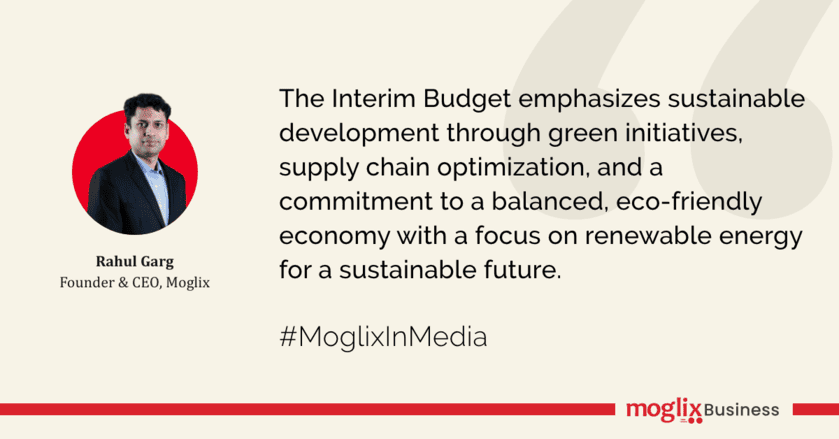
Budget 2024 champions sustainable supply chain solutions, spanning from green hydrogen to bioplastics
The budget’s robust 11.1% increase in capital expenditure signifies the government’s commitment to development. This commitment is further demonstrated by allocating ₹1 lakh crore for the Green Hydrogen Mission and promoting sustainable mobility, including metro network expansion and electric vehicle adoption. These measures reflect a balanced approach, integrating development and sustainability for the nation’s progress.
Read MoreAdvancing Feedback: Cultivating a Culture of Continuous Enhancement
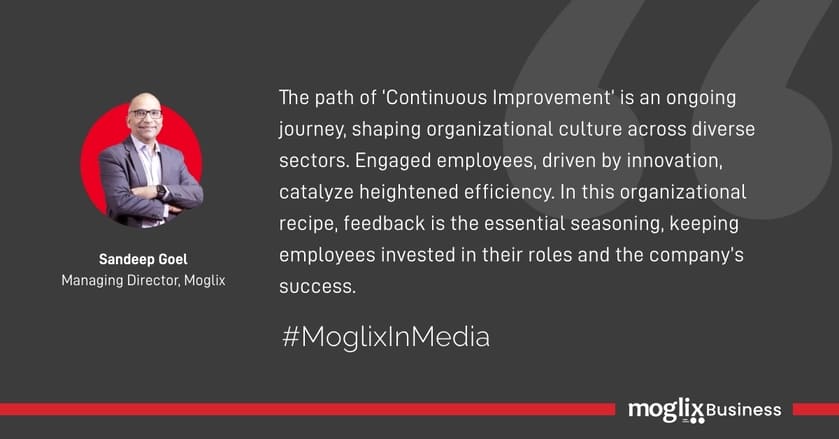
Advancing Feedback: Cultivating a Culture of Continuous Enhancement
Enthusiastic employees exhibit creative thinking, enhancing overall efficiency. Feedback serves as a crucial element in organizational policies designed to engage and retain employees. Explore optimal strategies for fostering continuous improvement in our examination of key practices.
Read More2024 Procurement Outlook for Structural Steel for CPOs of Infrastructure Project Developers in India

2024 Procurement Outlook for Structural Steel for CPOs of Infrastructure Project Developers in India
Picture this: In 2023, navigating the procurement of steel TMT bars was like steering through a financial maze. The prices varied significantly – 10mm GBR TMT bars were between Rs. 68,000 and Rs. 72,000 per tonne, while 8mm Tata TMT Bars stood around Rs. 56/kg.
Forecasting TMT bar prices for the 2024 procurement outlook is difficult due to unpredictable changes in demand, supply dynamics, and global economic trends. However, projections suggest that there may be occasional price decreases in the upcoming months, although the market is anticipated to experience consistent growth until 2031. Let us cooperate to address these issues and make educated purchase decisions in 2024.
Cost Drivers Affecting the Steel Supply Chain in 2024
Raw Material Cost
During 2024, the steel supply chain went through tough challenges. It was influenced by rising prices of raw materials like iron ore and scrap metal and geopolitical events such as the Ukraine War and trade sanctions. For 2024, we expect a 3.2% increase in raw material costs in the first five months. This scenario directly impacts steel production costs and final product prices.
Electricity Cost
Despite growing energy prices, particularly electricity, the World Steel Association predicts a moderate % growth rate of 2% in 2024 for TMT steel procurement in India. This challenge is offset by robust domestic and foreign demand. Government policies and initiatives will be instrumental in shaping the steel sector’s future.
Coking Coal Cost
Coking coal costs are poised to rise due to the Ukraine war and disruptions in Central Asia, impacting TMT steel production expenses.
For the 2024 procurement outlook, Hard coal is anticipated to cost 202.6 USD/MT, while semi-soft coal will cost 144.1 USD/MT.
The Ukraine situation may cause logistical issues that disrupt global steel demand and supply networks, resulting in shortages and higher prices.
Additionally, imports, influenced by global trends and trade policies, will significantly shape TMT steel prices.
Logistics Cost
Logistics and fuel prices are key factors influencing final costs. Fluctuations in these areas, particularly fuel prices, significantly affect TMT rod production costs, as outlined by Captain TMT.
Gasoline and diesel prices may fall before the 2024 Lok Sabha elections, alleviating this effect. The TMT steel bar business is also growing due to rising demand for inexpensive reinforcing bars.
Project Finance Cost
In 2024, project finance costs in India’s TMT steel sector are poised to rise due to increased interest rates, inflation, and currency fluctuations, impacting capital and operating expenses. This scenario could elevate TMT bar production costs, as IMARC Group and CivilSite highlighted. Various economic factors will influence loan terms from banks and financial institutions and will affect the steel sector’s cash flow and pricing strategies. Additionally, these costs will influence investment decisions, impacting the sector’s competitiveness and market share, as noted in Economic Times and Moneycontrol reports.
Working Capital Cost
In 2024, India’s TMT bar producers can expect reduced working capital costs. Driven by strong demand in infrastructure and realty, as noted in The Hans India, improved sales and cash flow will lessen reliance on external financing. Enhanced production capacities will reduce inventory costs, improving working capital efficiency. Government incentives and policies, detailed by IMARC Group and Economic Times, will further aid in easing financial constraints, bolstering the sector’s economic footing.
Labour Cost
In 2024, India’s TMT steel bar production faces potential cost increases due to rising labor costs, including wages and benefits. This surge could elevate production costs, squeezing profit margins and competitiveness. Additionally, a skilled labor shortage may impact productivity and innovation, influencing supply-demand dynamics in the procurement industry. Labor cost changes will also be crucial in the sector’s investment decisions and technology adoption.
O&M Cost
Operating and Maintenance (O&M) costs in India’s TMT steel bar sector are projected to rise in 2024 due to increasing energy prices, labor costs, and stringent environmental regulations. This increase could lead to higher production costs, impacting profit margins and competitiveness. Furthermore, efficiency issues in steel plants and equipment due to aging or technical challenges may affect productivity and market dynamics, influencing key decisions in technology adoption and investment strategies within the sector.
Steel TMT Bar Procurement Solutions for CPOs of Infrastructure Project Developers
Spend Analytics for Cost Optimization
Navigating the procurement of Steel TMT bars, crucial for infrastructure projects and accounting for a significant 40% of construction costs, requires strategic approaches for cost optimization. Spend analytics offers a comprehensive view of spending patterns, which is crucial for identifying cost variations and potential savings. Implementing this can lead to an average of 6% savings on total spending.
Site Aggregation for JIT Supplies
Site aggregation for Just-In-Time supplies is another effective strategy. Consolidating demands across sites not only reduces transportation and handling costs but also aligns with JIT principles, potentially saving up to 10% on logistics costs.
Local Sourcing for Logistics Cost Reduction
Lastly, local sourcing significantly reduces logistics expenses, supporting community relations and reducing environmental impact. As per a McKinsey study, this approach can reduce logistics costs by 15-20%.
Conclusion
The 2024 procurement outlook for TMT steel bars presents a complex blend of challenges and opportunities. Strong demand and possible cost reductions in working capital and labor support the sector despite variable raw materials, electricity, coal, logistics, project finance, and O&M costs. These dynamics require strategic measures like expenditure analytics, site aggregation, and local sourcing to save money and increase efficiency. For competitive advantage, infrastructure project developers must react to these developments. Explore Moglix Business for TMT steel bar, crash barriers and bitumen procurement solutions.
Insights on India`s Economic Transformation from the Interim Union Budget 2024
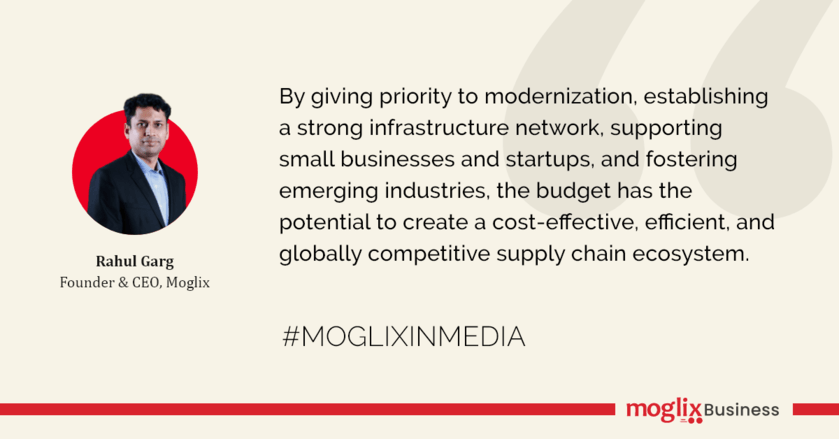
Insights on India`s Economic Transformation from the Interim Union Budget 2024
As India aims for a USD 4 trillion GDP, the pivotal role of its manufacturing and logistics sectors in unlocking potential and driving national growth cannot be overstated. The imminent Union Budget emerges as a vital guide, directing policies and allocations to bring about transformation in these critical segments of the economy.
Read MoreInc42 and Databricks Roundtable
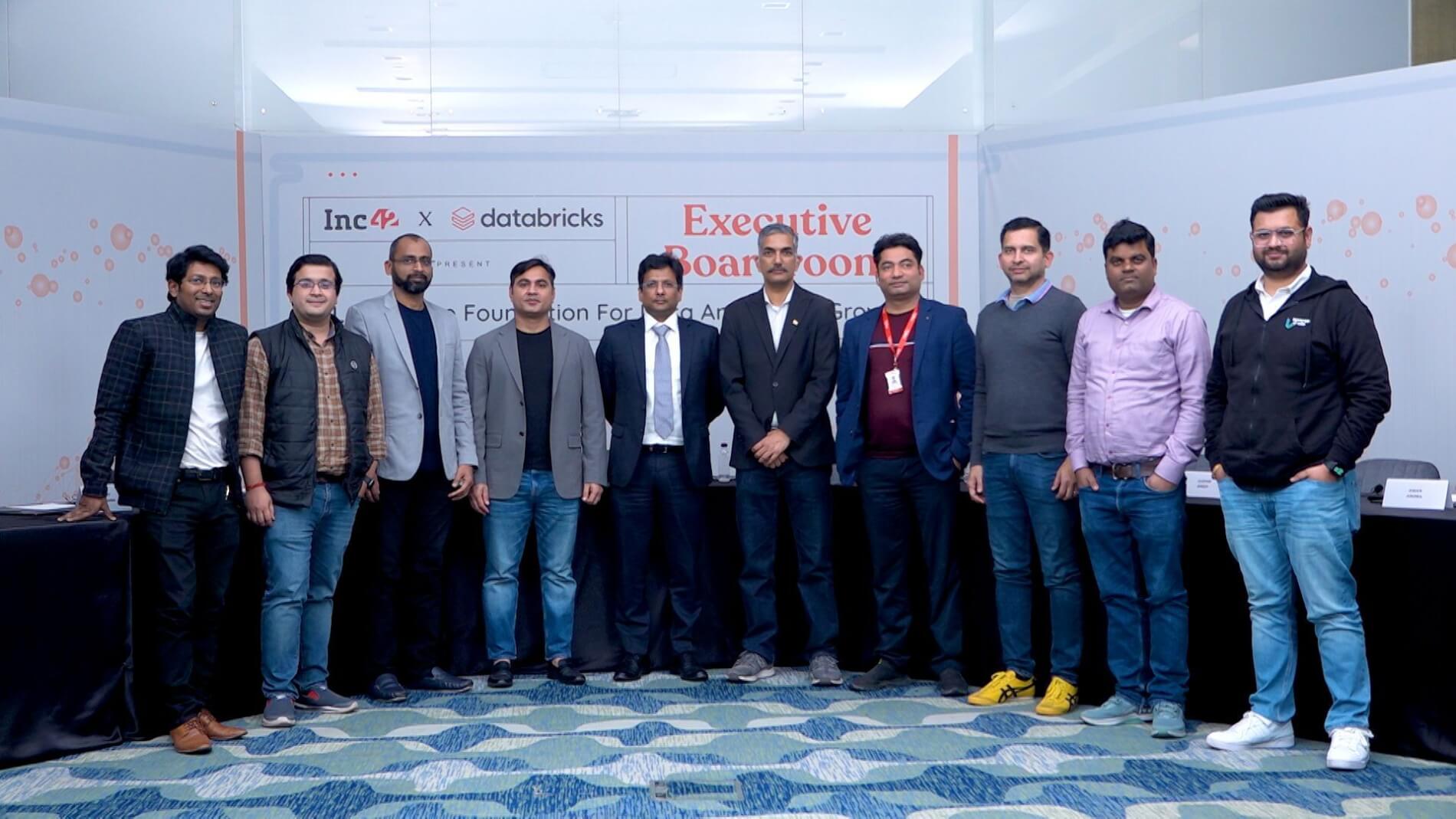
Inc42 and Databricks Roundtable
Date: 30th January, 2024
Organizer: Inc42
About the Event: Mr. Shiva Nand Singh, Director-Technology at Moglix, shared his expertise at the Inc42 Media roundtable series on “Hype to Reality: Demystifying Generative AI’s Role in Reshaping Data Strategies and Fighting Deployment Battles
The Union Budget`s Impact on Fueling Supply Chain Advancements
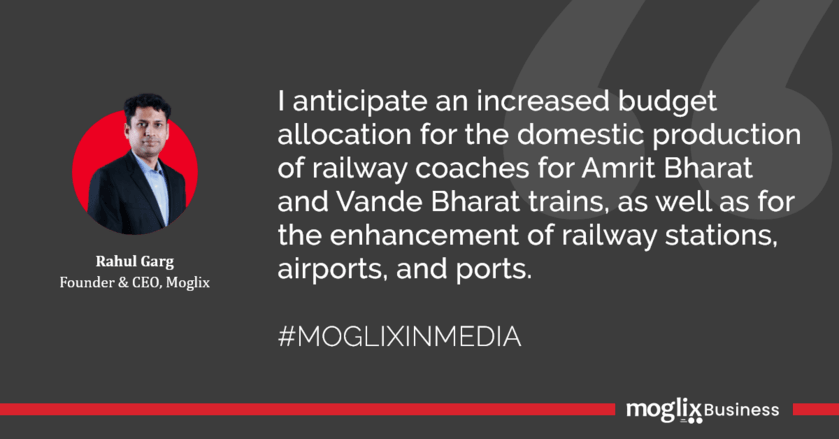
The Union Budget`s Impact on Fueling Supply Chain Advancements
As India strides towards achieving its $4 trillion GDP target in 2024, all eyes are on the impending Union Budget. Serving as a fiscal compass, this budget possesses the potential to reshape the nation’s industrial landscape and supply chain infrastructure. Let’s explore the anticipated aspirations of the supply chain industry, analyzing specific areas where strategic incentives and allocations could unlock significant potential.
Read MoreUnion Budget 2024: A Forward-Thinking Approach to Prolonged Support for Ambitious Infrastructure Development Plans
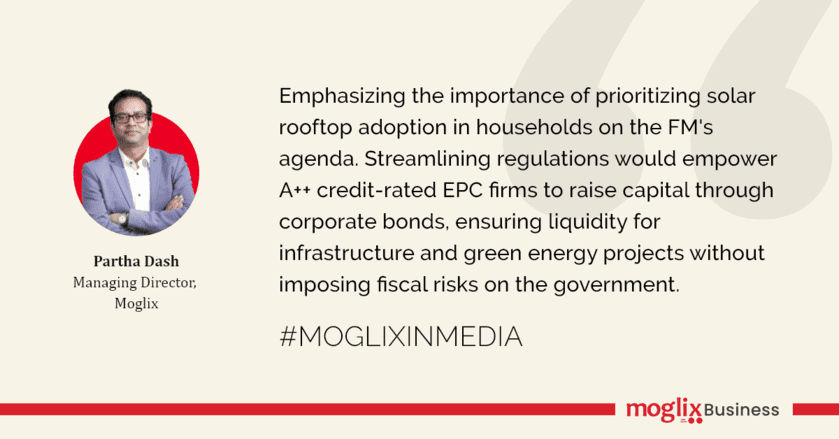
Union Budget 2024: A Forward-Thinking Approach to Prolonged Support for Ambitious Infrastructure Development Plans
Ensuring a steady trajectory and momentum in infrastructure development remains a key expectation for the Union Budget 2024. The ambitious proposal to construct 91 airports and develop 100 smart cities is poised to receive prolonged financial support, reflecting a commitment to bolstering the country’s connectivity and urban landscape.
Read More2024 Fabrication Outlook for Project Heads of EPC Project Developers in India

2024 Fabrication Outlook for Project Heads of EPC Project Developers in India
The year 2024 will present a series of dynamic and transformative growth opportunities for EPC project developers in India. The center is fusing Rs 143 lakh crore into modernized railway infra, clean energy, power, and defense sectors. Thus, EPC project heads should prepare to be a part of this sustainable development for reshaping India’s industrial future. In this regard, let’s look at some key events that EPC project heads should consider as their golden ticket to big growth and transformation.
Events in 2024 That Project Heads of EPC Project Developers Should Watch Out For
Four essential 2024 fabrication outlook agendas for EPC project heads:
Railway Infrastructure Spending
India plans a massive upgrade of its railway infrastructure through significant investments and technology improvements. The proposed purchase of 8 high-speed bullet trains promises enhanced connectivity and reduced travel times. Additionally, the redevelopment of over 1,300 stations aims to improve passenger experience while enabling infrastructure growth. Along the same line, the government has ambitious plans to invest in 400 Vande Bharat trains and 3000 new passenger trains in 5 years to demonstrate a commitment to expanding and upgrading the railway network. These projects offer EPC firms ample contracts and tenders for civil construction, signaling, electrification, and rolling stock.
Clean Energy for Mobility
India’s clean mobility sector holds promising growth potential. The goal to command 30% of the global clean mobility market by 2030 reflects an aggressive sustainable transportation push. This entails ₹30 lakh crore investments, with ₹8 lakh crore for green hydrogen development to revolutionize car fuels in years to come. This could be a great opportunity for EPC heads to prepare for addressing concerned manufacturing, charging infrastructure, and energy storage solutions.
Power and Energy
India’s power sector will likely undergo rapid expansion. With power consumption projected to reach 4 trillion units by 2030, growing at 13% CAGR, the sector’s total addressable market is estimated at ₹24 lakh crore. This trajectory offers renewable energy, grid modernization, and energy efficiency prospects.
Defense Sector Spending
India’s defense sector, already the 4th highest global spender, offers emerging EPC potential. Exports to 84 countries and 20% CAGR in defense exports showcase robust expansion. The sector eyes ₹1.75 lakh crore turnover by 2025, presenting infrastructure, manufacturing and maintenance opportunities.
Fabrication Solutions that Project Heads of EPC Project Developers Should Adopt in 2024
Invest in Plant Capacity Expansion and Geographical Diversification
How can your company handle big projects without capacity and service upgrades? It’s crucial. Expanding plant capacity and upgrading machinery and technology is crucial for meeting rising project demand and complexity. Geographical diversification reduces logistics challenges and costs while positioning firms closer to project sites and raw materials, enabling faster, more efficient execution.
Control OPEX Costs & Outsource Auxiliary Works
Almost 27% of organizations outsource to reduce operational costs. Outsourcing non-core activities like painting, fabrication, and welding to specialized subcontractors can significantly reduce operational expenditures. This allows focusing on core competencies while leveraging efficiencies of scale and expertise.
Develop Captive Suppliers with JIT and VMI Capabilities
Imagine the peace of eliminating inventory while accessing materials on-demand from vendors with fast delivery. Establishing captive suppliers with Just-In-Time and Vendor Managed Inventory capabilities can do the same to streamline supply chains. This approach reduces inventory costs and ensures timely material availability, minimizing delays and cost overruns.
Onboard Suppliers onto the Digital Platform
Nearly 83% of CPOs consider digitizing the procurement for enhanced efficiency. Integrating suppliers into a digital project management platform enhances communication, transparency, and real-time tracking of material and progress with ease.
Explore Early Supplier Payment for Bottlenecks
Around 71% of companies feel raw material costs are one of the major supply chain threats. Therefore, EPC firms should consider early payment for bottleneck items to ensure all essential construction materials are available to handle dynamic project requirements and to build strong relationships with suppliers.
Explore Moglix Business custom fabrication solutions here.
